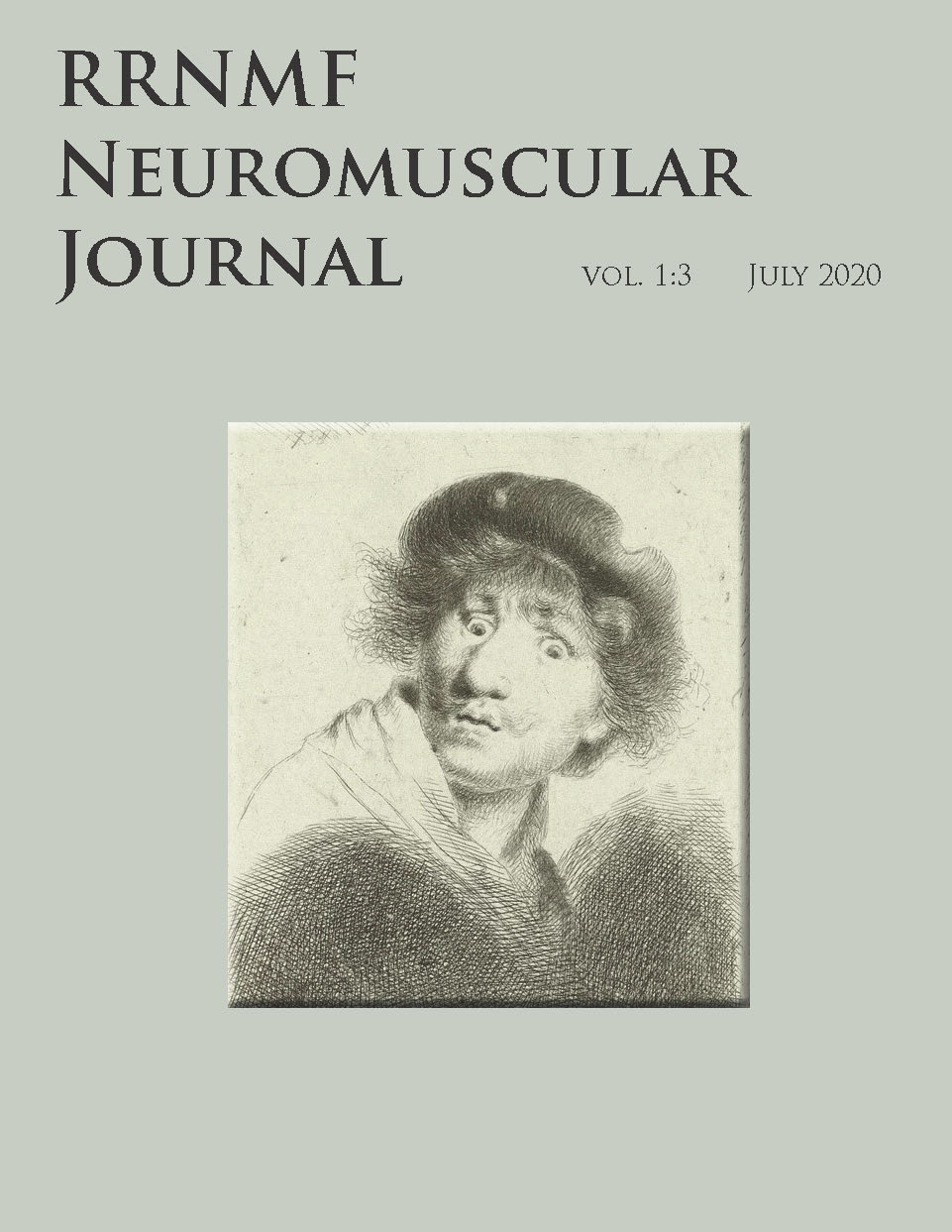Rhabdomyolysis and COVID-19 Infection: Is It Due to Statin Use or Anti-TIF1-y Antibodies?
DOI:
https://doi.org/10.17161/rrnmf.v1i3.13719Keywords:
COVID-19, SARS-CoV-2, rhabdomyolysis, myositis, inflammatory myopathy, anti-TIF1-y antibodyAbstract
Coronavirus disease 2019 (COVID-19), now a global pandemic, has infected millions of people and caused hundreds of thousands of deaths. Neurological presentation of the novel coronavirus includes headaches, seizures, myalgias, hyposmia, ageusia, etc. Guillain-Barre Syndrome (GBS) and its variant, Miller Fisher Syndrome, have been reported in COVID-19 patients presenting with lower limb weakness, paresthesia, facial diplegia, and ataxia. Most recently, large vessel occlusion strokes were seen in infected younger patients without vascular risk factors. We present a novel case of rhabdomyolysis associated with COVID-19 infection in a patient on atorvastatin, in whom we detected positive anti-transcriptional intermediary factor 1 gamma antibodies (anti-TIF1-y Ab). Bilateral upper and lower extremity weakness improved with aggressive fluid administration and intravenous immunoglobulin (IVIg) at 0.4mg/kg for a total of 5 days. Interrupting a strong cytokine response with IVIg early on during the disease may have led to rapid improvement.
Downloads
References
2. Bersano A, Pantoni L. On being a neurologist in Italy at the time of the COVID-19 outbreak. Neurology. 2020. doi:10.1212/wnl.0000000000009508
3. Wang D, Hu B, Hu C, et al. Clinical Characteristics of 138 Hospitalized Patients With 2019 Novel Coronavirus–Infected Pneumonia in Wuhan, China. Jama. 2020;323(11):1061. doi:10.1001/jama.2020.1585
4. Guan W-J, Ni Z-Y, Hu Y, et al. Clinical characteristics of 2019 novel coronavirus infection in China. N Engl J Med. 2020 Apr 30;382(18):1708-1720. doi: 10.1056/NEJMoa2002032. Epub 2020 Feb 28. PMID: 32109013 doi:10.1101/2020.02.06.20020974
5. Huang C, Wang Y, Li X, et al. Clinical features of patients infected with 2019 novel coronavirus in Wuhan, China. The Lancet. 2020;395(10223):497-506. doi:10.1016/s0140-6736(20)30183-5
6. Chen N, Zhou M, Dong X, et al. Epidemiological and Clinical Characteristics of 99 Cases of 2019-Novel Coronavirus (2019-nCoV) Pneumonia in Wuhan, China. SSRN Electronic Journal. 2020. doi:10.2139/ssrn.3523861
7. Toscano G, Palmerini F, Ravaglia S, et al. Guillain–Barré Syndrome Associated with SARS-CoV-2. New England Journal of Medicine. 2020. doi:10.1056/nejmc2009191
8. Gutiérrez-Ortiz C, Méndez A, Rodrigo-Rey S, et al. Miller Fisher Syndrome and polyneuritis cranialis in COVID-19. Neurology. 2020. doi:10.1212/wnl.0000000000009619
9. Oxley TJ, Mocco J, Majidi S, et al. Large-Vessel Stroke as a Presenting Feature of Covid-19 in the Young. New England Journal of Medicine. 2020. doi:10.1056/nejmc2009787
10. Beydon M, Chevalier K, Tabaa OA, et al. Myositis as a manifestation of SARS-CoV-2. Annals of the Rheumatic Diseases. 2020. doi:10.1136/annrheumdis-2020-217573
11. Lin L, Lu L, Cao W, Li T. Hypothesis for potential pathogenesis of SARS-CoV-2 infection–a review of immune changes in patients with viral pneumonia. Emerging Microbes & Infections. 2020;9(1):727-732. doi:10.1080/22221751.2020.1746199
12. Masiak A, Kulczycka J, Czuszyńska Z, Zdrojewski Z. Clinical characteristics of patients with anti-TIF1-γ antibodies. Reumatologia/Rheumatology. 2016;1:14-18. doi:10.5114/reum.2016.58756
13. Okogbaa J, Batiste L. Dermatomyositis: An Acute Flare and Current Treatments. Clinical Medicine Insights: Case Reports. 2019;12:117954761985537. doi:10.1177/1179547619855370
14. Dimachkie MM, Barohn RJ, Amato AA. Idiopathic inflammatory myopathies. Neurol Clin. 2014 Aug;32(3):595-628, vii. doi: 10.1016/j.ncl.2014.04.007. Review. PMID: 25037081
15. Tay MZ, Poh CM1, Rénia L, MacAry PA Ng LFP. The trinity of COVID-19: immunity, inflammation and intervention. Nat Rev Immunol. 2020 Apr 28. doi: 10.1038/s41577-020-0311-8. [Epub ahead of print]
Downloads
Published
Issue
Section
License
Copyright (c) 2020 Emmanuel Mantilla, Mamatha Pasnoor, Mazen Dimachkie

This work is licensed under a Creative Commons Attribution-NonCommercial-NoDerivatives 4.0 International License.

